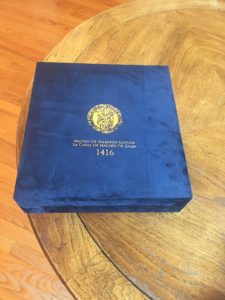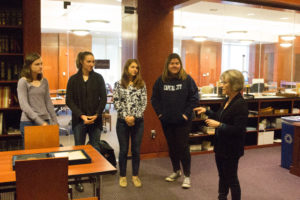Down in the belly of Special Collections sits a mysterious blue velvet box. Its contents are simultaneously mundane and bizarre, important for the study of language in Spain, and remarkably unremarkable. The box bears the inscription Matxin de Zalbaren Gutuna, La Carta de Machin de Zalba, 1416. What is it? Why do we have it? What makes it both special and ordinary?
 Basque manuscript, Matxin de Zalbaren Gutuna, La Carta de Machin de Zalba, 1416
Basque manuscript, Matxin de Zalbaren Gutuna, La Carta de Machin de Zalba, 1416
It’s a facsimile of notes written at the beginning of the 15th century by court officials in the Navarre region of northern Spain. Seemingly commonplace, the note asks for explanation of a small budget deficiency before delving into the personal matter of dinner party attendance. Also included further down the page is the note’s reply. What’s really exciting is how the document is written. The first note starts in Romance (Spanish) before switching to the Basque language. The reply is written primarily in Basque. Before the discovery of the original, historians and linguists questioned whether or not the Basque language was widely spoken in Navarre. This example of high officials communicating in Basque, provides evidence that not only was the language writable and readable, but it was used by more than merely the lowest classes.
Dr. Lu Ann Homza generously donated Matxin de Zalbaren Gutuna, La Carta de Machin de Zalba in 2016. This is the most sizable example of Basque language writing before the Modern Era. It’s also the only extant text written in Basque before 1500. We have one of 356 copies made, one of only two listed on WorldCat, and the only one at an American university.
 Dr. Lu Ann Homza, students, and SCRC director Gerald "Jay" Gaidmore take a photo with the manuscript.
Dr. Lu Ann Homza, students, and SCRC director Gerald "Jay" Gaidmore take a photo with the manuscript.
 Dr. Lu Ann Homza and her students traveled to Spain, where they received the manuscript facsimile as a gift from the Archivo Real y General de Navarra in Pamplona, Spain (Royal General Archive of Navarre).
Dr. Lu Ann Homza and her students traveled to Spain, where they received the manuscript facsimile as a gift from the Archivo Real y General de Navarra in Pamplona, Spain (Royal General Archive of Navarre).
Written by Jane Snyder, Graduate Apprentice